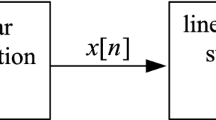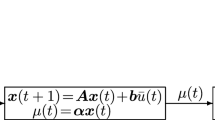Abstract
This paper investigates the modeling of a class of dynamic systems using nonlinear Hammerstein (NLH) model composed of a memory-less polynomial block cascaded to an autoregressive with exogenous input (ARX) time-series block. The model thus defined is known as NLHARX. Both the integer orders and the real coefficients of the model are identified simultaneously in a unified framework using a new algorithm based on a mixed coded integer-real particle swarm optimization. Unlike classical identification methods which assume the orders to be known in advance, the proposed approach is new since it estimates both the real and integer design parameters while minimizing the error between the outputs of the system and the model. The usefulness and the effectiveness of the proposed approach have been demonstrated through extensive simulations. Two illustrative examples are included in this paper: an empirical example and an application to the forecasting of the daily peak-load of Hail region, Saudi Arabia. Future works will be devoted to the identification of more complex dynamic systems, such as Hammerstein–Wiener and the application to the prediction of time-series related to water and energy.














Similar content being viewed by others
References
Wills, A., Schon, T.B., Ljung, L., Ninness, B.: Identification of Hammerstein–Wiener models. Automatica 49, 70–81 (2013)
Jingzhuo, S., Juanping, Z., Jingtao, H., Meiyu, X., Juwei, Z., Lei, Z.: Identification of ultrasonic motor’s nonlinear Hammerstein model. J. Autom. Electr. Syst. 25, 537–546 (2014)
Wang, D.F., Ren, Y.Y., Liu, C.L., Han, P.: Identification of thermal process using Hammerstein model based on particle swarm optimization algorithm. Lect. Notes Electr. Eng. 238, 1961–1968 (2014)
Jurado, F.: Modelling micro-turbines using Hammerstein models. Int. J. Energy Res. 29, 841–855 (2005)
Butcher, M., Giustiniani, A., Masi, A.: On the identification of Hammerstein systems in the presence of an input hysteretic nonlinearity with nonclonal memory: piezoelectric actuators—an experimental case study. Physica B 486, 101–105 (2016)
Ding, F., Chen, T.: Identification of Hammerstein nonlinear ARMAX systems. Automatica 41, 1479–1489 (2005)
Xu, B.-C., Zhang, Y.-D.: New identification method for Hammerstein models based on approximate least absolute deviation. Int. J. Syst. Sci. 47(9), 2201–2213 (2016)
Maatallah, O.A., Achuthan, A., Janoyan, K., Marzocca, P.: Recursive wind speed forecasting based on Hammerstein auto-regressive model. Appl. Energy 145, 191–197 (2015)
Zhao, W.X., Chen, H.F., Zhou, T.: New results on recursive identification on NARX systems. Int. J. Adapt. Control Sig. Process. 25, 855–875 (2011)
Ma, L., Liu, X.: Recursive maximum likelihood method for the identification of Hammerstein ARMAX system. Appl. Math. Model. 40, 6523–6535 (2016)
Chaoui, F.Z., Giri, F., Rochdi, Y., Haloua, M., Naitali, A.: System identification based on Hammerstein model. Int. J. Control 78(6), 430–442 (2005)
Ding, F., Shi, Y., Chen, T.: Gradient-based identification methods for Hammerstein nonlinear ARMAX models. Nonlinear Dyn. 45, 31–43 (2005)
Chen, J., Wang, X.: Identification of Hammerstein systems with continuous nonlinearity. Inf. Process. Lett. 115, 822–827 (2015)
Al-Duwaish, H.N., Azhar Ali, S.S.: Hammerstein model identification using radial basis functions neural networks. In: ICANN, pp. 951–956 (2001)
Cui, M., Liu, H., Li, Z., Tang, Y., Guan, X.: Identification of Hammerstein model using functional link artificail neural network. Neurocomputing 142, 419–428 (2014)
Pal, P.S., Kar, R., Mandal, D., Ghoshal, S.P.: Identification of NARMAX Hammerstein models with performance assessment using brain storm optimization algorithm. Int. J. Adapt. Control Sig. Process. 30, 1043–1070 (2016)
Zhang, D.L., Tang, Y.G., Ma, J.H., Guan, X.P.: Identification of Wiener model with discontinuous nonlinearities using differential evolution. Int. J. Control Autom. Syst. 11(3), 511–518 (2013)
Naitali, A., Giri, F.: Wiener–Hammerstein system identification—an evolutionary approach. Int. J. Syst. Sci. 47(1), 45–61 (2015)
Tang, Y., Qiao, L., Guan, X.: Identification of Wiener model using step signals and particle swarm optimization. Expert Syst. Appl. 37, 3398–3404 (2010)
Fan, H., Lin, W.: Parameter estimation of the MISO nonlinear system based on improved particle swarm optimization. Appl. Mech. Mater. 130–134, 2563–2567 (2012)
Ma, J., Zhao, L., Han, Z., Tang, Y.: Identification of Wiener model using least squares support vector machine optimized by adaptive particle swarm optimization. J. Control Autom. Electr. Syst. 26, 609–615 (2015)
Nanda, S.J., Panda, G., Majhi, B.: Improved identification of Hammerstein plants using new CPSO and IPSO algorithms. Expert Syst. Appl. 37, 6818–6831 (2010)
Hachino, T., Yamakawa, S.: Non-parametric identification of continuous-time Hammerstein systems using Gaussian process model and particle swarm optimization. Artif. Life Robot. 17, 35–40 (2012)
Sun, J., Liu, X.: A novel APSO-aided maximum likelihood identification method for Hammerstein systems. Nonlinear Dyn. 73, 449–462 (2013)
Al-Duwaish, H.N.: Identification of Hammerstein models with known nonlinearity structure using particle swarm optimization. Arab. J. Sci. Eng. 36, 1269–1276 (2011)
Zhang, Q., Wang, Q., Li, G.: Nonlinear modeling and predictive functional control of Hammerstein system with application to the turntable servo system. Mech. Syst. Sig. Process. 72–73, 383–394 (2016)
Wang, J., Zhang, Q.: Detection of asymmetric control valve stiction from oscillatory data using an extended Hammerstein system identification method. J. Process Control 24, 1–12 (2014)
Fragkoulis, D., Roux, G., Dahhou, B.: Detection, isolation and identification of multiple actuator and sensor faults in nonlinear dynamic systems: application to a waste water treatment process. Appl. Math. Model. 35, 522–543 (2011)
Trelea, I.C.: The particle swarm optimization algorithm: convergence analysis and parameter selection. Inf. Process. Lett. 85, 317–325 (2003)
Clerc, M., Kennedy, J.: The particle swarm-explosion, stability, and convergence in a multidimensional complex space. IEEE Trans. Evol. Comput. 6(1), 58–73 (2002)
del Valle, Y., Venayagamoorthy, G.K., Mohagheghi, S., Hernandez, J.-C., Harley, R.G.: Particle swarm optimization: basic concepts, variants and applications in power systems. IEEE Trans. Evol. Comput. 12(2), 171–195 (2008)
Sivanagaraju, S., Rao, J.V., Raju, P.S.: Discrete particle swarm optimization to network reconfiguration for loss reduction and load balancing. Electr. Power Compon. Syst. 36, 513–524 (2008)
Uilhoorn, F.E.: Comparison of two non-convex mixed-integer nonlinear programming algorithms applied to autoregressive moving average model structure and parameter estimation. Eng. Optim. 48(10), 1693–1706 (2016)
Parsopoulos, K.E., Vrahatis, M.N.: Recent approaches to global optimization problems through particle swarm optimization. Nat. Comput. 1, 281–288 (2002)
El-Telbany, M., El-Karmi, F.: Short-term forecasting of Jordanian electricity demand using particle swarm optimization. Electr. Power Syst. Res. 78, 425–433 (2008)
Liu, G., Guo, W., Niu, Y., Chen, G., Huang, X.: A PSO-based timing-driven Octilinear Steiner tree algorithm for VLSI routing considering ben reduction. Soft. Comput. 19, 1153–1169 (2015)
Baguda, Y.S., Fisal, N., Rashid, R.A., Yusof, S.K., Syed, S.H., Shuaibi, D.S.: In: Abd Manaf, A., et al. (eds.) Low Complexity PSO-Based Multi-objective Algorithm for Delay-Constraint Applications, pp. 274–283. Springer, Berlin (2011)
Acknowledgements
This research Project has been supported by the Grant of the Deanship of Scientific Research of Hail University, Saudi Arabia, under the No. 150460. I would like to acknowledge the University for its Support. I am also indebted to Engineers Majid AlShammari, Habib Fathalli and Yusuf AlShammari (from Hail II power plant, Saudi Electricity Company) for providing the data of load and peak-load.
Author information
Authors and Affiliations
Corresponding author
Rights and permissions
About this article
Cite this article
Boubaker, S. Identification of nonlinear Hammerstein system using mixed integer-real coded particle swarm optimization: application to the electric daily peak-load forecasting. Nonlinear Dyn 90, 797–814 (2017). https://doi.org/10.1007/s11071-017-3693-9
Received:
Accepted:
Published:
Issue Date:
DOI: https://doi.org/10.1007/s11071-017-3693-9




